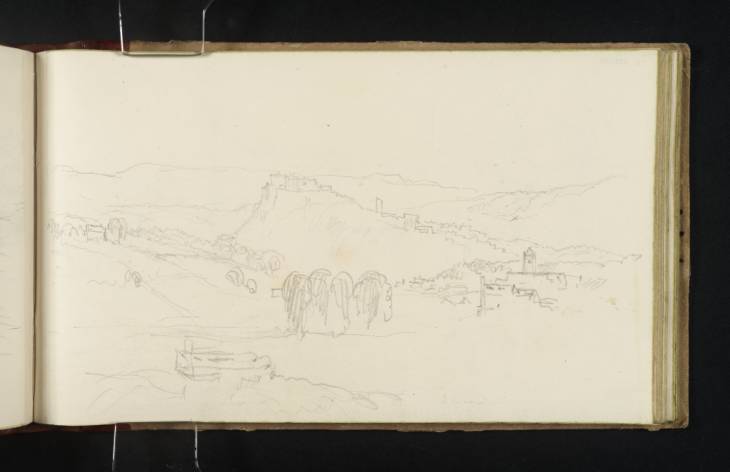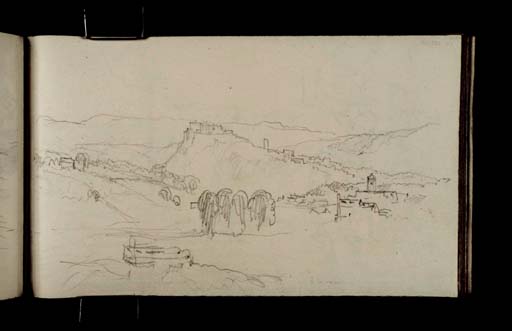Joseph Mallord William Turner Stirling Castle and St Ninians from the Battlefield of Bannockburn 1834
Image 1 of 2
Joseph Mallord William Turner,
Stirling Castle and St Ninians from the Battlefield of Bannockburn
1834
Joseph Mallord William Turner 1775–1851
Folio 46 Verso:
Stirling Castle and St Ninians from the Battlefield of Bannockburn 1834
D26346
Turner Bequest CCLXIX 46a
Turner Bequest CCLXIX 46a
Pencil on off-white wove paper, 113 x 190 mm
Accepted by the nation as part of the Turner Bequest 1856
References
1909
A.J. Finberg, A Complete Inventory of the Drawings of the Turner Bequest, London 1909, vol.II, p.866, CCLXIX 46a, as ‘Stirling.’.
1936
Henry J. Crawford, Turner’s Sketches and Drawings of Stirling and Neighbourhood with Some Notes on the Artist’s Scottish Tours also a Note on John Ruskin and Stirling, Stirling 1936, pp.1–3 reproduced in black and white, p.26.
1990
Dr David Wallace-Hadrill and Janet Carolan, ‘Turner’s Sketches North of Stirling’, Turner Studies: His Art and Epoch 1775 – 1851, Vol.10 No.1, Summer 1990, p.12.
1990
Dr David Wallace-Hadrill and Janet Carolan, ‘Turner North of Stirling in 1831; a checklist (2)’, Turner Studies: His Art and Epoch 1775–1851, Vol.10 No.2, Winter 1990, p.31.
As Henry Crawford observed, this view of Stirling Castle with the village of St Ninians to the right was made from the south of the city near Borestone.1 The castle sits atop Castle Rock at the centre of the page with the Holy Rude church to its right. In the middle distance to the right is the village of St Ninians with the church tower rising above it. There are also, as Crawford noted, ‘trees and [a] stone in [the] foreground’,2 which, according to David Wallace-Hadrill, provide ‘a strong middle distance.’3 The latter noted how the ‘shading suggests an eastern light’,4 and Crawford described this as ‘a beautiful little sketch’.5
Despite these writers’ obvious interest and affection for the sketch, however, neither seems to have discovered the significance of the view or of the large rectangular stone in the foreground. This is a view from Borestone Brae, a low hill just south of the village of Borestone near Stirling, and the stone is the Bore Stone, which is said to have been where Robert Bruce’s standard was erected during the Battle of Bannockburn in 1314 (though this story is now thought to be apocryphal).6 Although the exact site of the battlefield in unknown, this spot is within the area of conflict and it was once thought to be the main battle ground.
This identification probably explains why Turner stopped at the southern outskirts of Stirling and tried out different compositions of the view of the city. The subject no doubt had touristic interest for the artist who always took an interest in the history of the places he visited and must have been inspired, like many, to take an interest in Scottish history by the works of Walter Scott.7 Although Turner did not work up a view of Bannockburn for an illustration to Scott, such a view may have been considered by the artist and the publisher Robert Cadell as a possible illustration to the first volume of Scott’s Tales of a Grandfather (1828), which included an account of the battle (chapter 10), and was published as volume 22 of the collected Prose Work by Cadell in 1836. In the event the volume was illustrated with Turner’s Edinburgh from St Anthony’s Chapel circa 1834 (whereabouts unknown)8 and Dunfermline circa 1834 (private collection),9 while a different view of Stirling circa 1834–5 (Glasgow Museums)10 was chosen to illustrate volume 23, which, according to Gerald Finley, referred to the reign of James V.11
The Bore Stone is seen again in a sketch on folio 47 (D26347) and there is a similar view on folios 45 verso–46 (D26344–D26345). Further sketches made from nearby, some of which may depict Bannock Burn, are on folios 47 verso–48 verso (D26348–D26350). For a full list of Turner’s sketches of Stirling in this book, see folio 44 verso (D26342).
Thomas Ardill
October 2010
‘Stirling, Borestone Brae, Bore Stones: Archaeological Notes’, Royal Commission on the Ancient and Historic Monuments of Scotland, 1963, accessed 14 October 2010, http://canmore.rcahms.gov.uk/en/site/46169/details/stirling+borestone+brae+bore+stone/ . The stone was removed in the mid 1960s but photographs reveal the similarity of its appearance to Turner’s sketch. For example see George Washington Wilson, Bannockburn. The Bore Stone, circa 1865–1885, photograph (albumen print), A. D. White Architectural Photographs, Cornell University Library (Accession Number: 15/5/3090.01235), USA. A rotunda now stands in its place with a monument and statue of Robert the Bruce and there is a Heritage Centre nearby.
For Turner’s relationship to Scott see Gerald Finley, Landscapes of Memory: Turner as Illustrator to Scott, London 1980. It is interesting to note that when he visited Inverness in 1831, Turner noted the battlefield of ‘Culloden Hil[l]’, making a rough sketch of the site from a distance, even though he did not actually visit it: Tate D27051; Turner Bequest CCLXXVII 4a.
How to cite
Thomas Ardill, ‘Stirling Castle and St Ninians from the Battlefield of Bannockburn 1834 by Joseph Mallord William Turner’, catalogue entry, October 2010, in David Blayney Brown (ed.), J.M.W. Turner: Sketchbooks, Drawings and Watercolours, Tate Research Publication, December 2012, https://www


